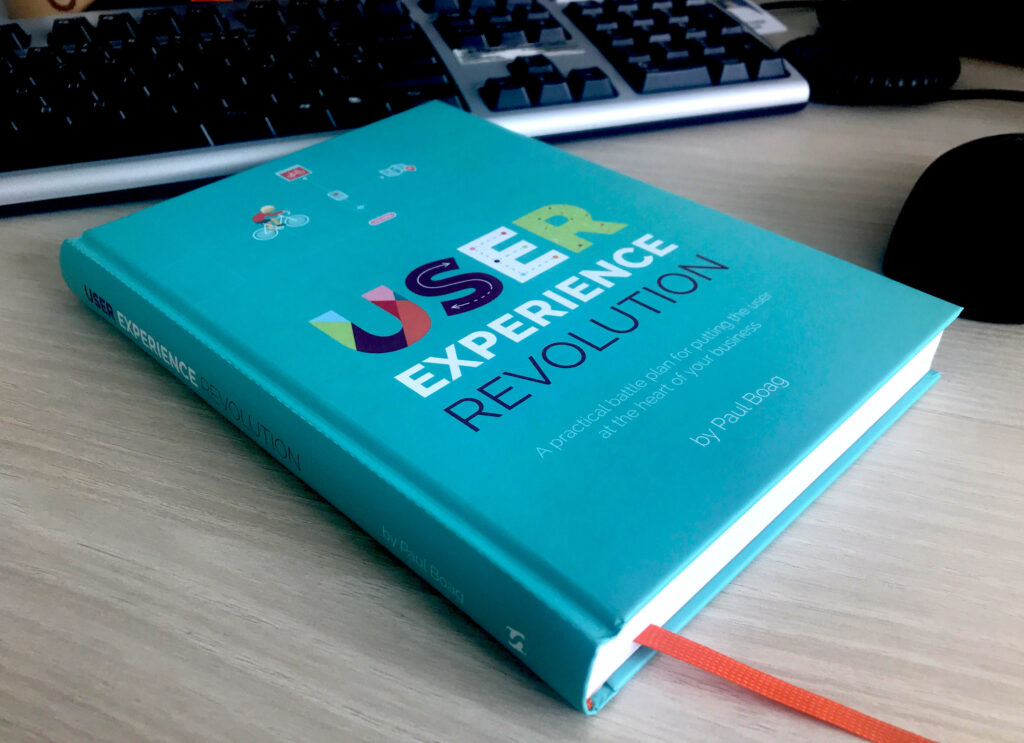Bringing the user experience to the heart of the company is a challenge extremely interesting. And like any challenge, it requires a battle plan. It is in cases like this that User Experience Revolution, one of the latest books from Smashing Magazine, in association with Paul Boag turns out to be an extremely effective companion.

Business from a UX perspective
"Walt Disney created user experiences. You create interfaces."
Mike Monteiro
The role of UX in business can still be quite poorly perceived. Not all companies have not the same level of maturity. Yet the user experience has never been so vital, at a time when 89% of users stop all contact with a company following a bad user experience.
However, Paul Boag points out in an extremely fair way that it is mainly up to the UX designer to undertake this work of evangelization and to succeed in overcoming and breaking the mentality in silos of contemporary companies. Going beyond these silos is done by going to meet your colleagues, by going to ask them about their jobs, their daily tasks, their challenges, … in short, to conduct a user analysis of their own environment !
Using the “shock” technique as momentum
Where these first bridges are commonly called "horizontal", Paul Boag is also interested in the need to create "vertical" bridges in the company, and expands his book of many scenarios where the user experience has brought a lot to a business: Apple Lossless Audio CODEC (ALAC), (of cours), Pzizz (which managed to save its entire business model by turning to its users), IBM (which has invested 100 million in the expansion of its user experience consulting service) and even the English government (which reduced its expenditure by 2 billion by moving 88% of its interactions with the citizen to digital platforms).
![]()
Quite rightly, the book points out that these directors were not convinced by the importance of the user experience but by a questioning the status quo. Demonstrating the interest of the user experience will always be extremely difficult (if not impossible) in front of managers, but pointing out the speed acquired by the competition, the lost market shares, the unnecessary expenses avoided, the dissatisfaction of the user base, etc. will, on the other hand, be a lever of phenomenal importance. In summary, Paul Boag offers a very simple approach to management: Shock them, inspire them, start small.
"What delighted users a few years ago is now the expected minimum level, the lack of which will result in a lot of frustration."
Phillip Tellis (engineer at Akamai)
The Trojan UX in business
But beyond these bridges, how to involve, interest your colleagues in the user experience and convince them of its merits?

This book gives a series of extremely important tools that I will try to summarize as simply as possible.
#1 Create a team of evangelists
There's a very good chance that you're not the only one interested in the user experience, if you look closely you should discover a multitude of people with the same interest. There is also a good chance that these people have a lot of frustration to express…
#2 Create a chat room
Un hotel Facebook, Yammer, Slack, or even weekly meetings, let your group come together and exchange all together.
#3 Let the frustration out
Human beings like to complain, it's a constant, but we tend to demonize this plaintive side. Gather your team and let them express themselves on these points of frustration, suddenly you will find yourself with a multitude of possible action points and problems to tackle!
#4 Create a vision
Working together to establish a series of principles, poster that you will use to promote the user experience within your company. Feel free to use tools like Tricide to vote and get inspired by the site Design Principle FTW if you need ideas
#5 Align your principles with management
Show rather than telling. Do not hesitate to quickly build a prototype to demonstrate a direct benefit. If you have to wait for permission to start a change, you won't get anywhere. Apologize if necessary but dare.
#6 Test your ideas
Qwhether through a mini site or a newsletter, share the ideas of your group, the articles that you find interesting in relation to the user experience. An advice ? Avoid the intranet, nobody ever goes there.
#7 Take a small pilot project
Once all these seeds are in place, take on a fairly small and go there thoroughly in the UX method. Give yourself the opportunity to fail without too many problems, but above all the chance to be able to succeed brilliantly and now have a model project to show that demonstrates the interest of the user experience better than any speech.
To conclude
UX in business remains a huge challenge that many of us have to take up, and will undoubtedly remain a challenge for quite some time. However, little by little the idea is gaining ground while the contributions and examples of successes are more and more obvious.
Rather than giving up, this book offers a real breath of fresh air as well as a multitude of weapons allowing you to face this challenge which may seem insurmountable at first sight.
Success is going from failure to failure without ever losing enthusiasm
Take Away
- To convince of the importance of UX disrupt the status quo by shocking
- Create a small team de UX enthusiasts
- Share your findings with the company
- Start a small project by putting all the chances on your side
Projects
- Design Experience Revolution is purchasable on Smashing Magazine
- Paul Boag , author of the book, maintains a blog and a podcast dedicated to UX: http://boagworld.com/
- Mike Monteiro, author (among others) of the book Design is a Job is the founder of Mule Design
- The translation of Designer's code of ethics by Mike Monteiro
- Design is a Job was written by Mike Monteiro. It gives a lot of keys to navigate the world of design.
- An article by Marie Serindou, UX Evangelist @UX Republic, to learn how not to ruin a UX innovation workshop
- The UX Cards to support your customers in their UX revolution.
Many thanks and see you soon!
Simon Vandereecken, UX-Evangelist @UXRepublic – @s1monvdk
UX/UI ECO-DESIGN # Paris
SMILE Paris
163 quay of Doctor Dervaux 92600 Asnières-sur-Seine
DESIGN THINKING: CREATING INNOVATION # Belgium
UX-REPUBLIC Belgium
12 avenue de Broqueville - 1150 Woluwe-Saint-Pierre
MANAGING AND MEASURING UX # Paris
SMILE Paris
163 quay of Doctor Dervaux 92600 Asnières-sur-Seine
DESIGN SPRINT: INITIATION & FACILITATION # Paris
SMILE Paris
163 quay of Doctor Dervaux 92600 Asnières-sur-Seine
UX-DESIGN: THE FUNDAMENTALS # Belgium
UX-REPUBLIC Belgium
12 avenue de Broqueville - 1150 Woluwe-Saint-Pierre
GOOGLE ANALYTICS 4 #Paris
SMILE Paris
163 quay of Doctor Dervaux 92600 Asnières-sur-Seine
ACCESSIBLE UX/UI DESIGN # Belgium
UX-REPUBLIC Belgium
12 avenue de Broqueville - 1150 Woluwe-Saint-Pierre
EXPERIENCE MAPPING # Paris
SMILE Paris
163 quay of Doctor Dervaux 92600 Asnières-sur-Seine













